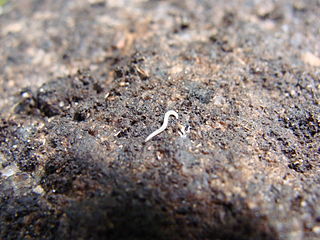
Dugesia is a genus of dugesiid triclads that contains some common representatives of the class Turbellaria. These common flatworms are found in freshwater habitats of Africa, Eurasia, and Australia. Dugesia is best known to non-specialists because of its regeneration capacities.
The Lake Pedder planarian is a species of invertebrate in the family Dugesiidae.
Romankenkius is a genus of freshwater planarian in the family Dugesiidae.

Geoplanidae is a family of flatworms known commonly as land planarians or land flatworms.

Bipalium is a genus of large predatory land planarians. They are often loosely called "hammerhead worms" or "broadhead planarians" because of the distinctive shape of their head region. Land planarians are unique in that they possess a "creeping sole", a highly ciliated region on the ventral epidermis that helps them to creep over the substrate. Native to Asia, several species are invasive to the United States, Canada, and Europe. Some studies have begun the investigation of the evolutionary ecology of these invasive planarians.

Continenticola is a clade that includes the land planarians (Geoplanidae) and the freshwater triclads.

Dugesiidae is a family of freshwater planarians distributed worldwide. The type genus is Dugesia Girard, 1850.

Girardia is a genus of freshwater planarians belonging to the family Dugesiidae.
Dugesia notogaea is a species of dugesiid triclad that inhabits freshwater bodies of north Queensland, Australia.

Geoplanoidea is a superfamily of freshwater and land triclads that comprises the species of the Geoplanidae and the Dugesiidae families.

Kenkiidae is a family of freshwater triclads. Their species can be found sporadically in caves, groundwater, and deep lakes in Central Asia, Far East and North America.

Dugesia japonica is a species of freshwater planarian that inhabits freshwater bodies of East Asia, including Japan, Korea, Taiwan, China and northeastern Siberia. However, molecular studies suggest that Dugesia japonica is polyphyletic and different populations across its area of occurrence constitute distinct species.
Cura is a genus of freshwater flatworm (triclads) belonging to the family Dugesiidae.

Microplaninae is a subfamily of land planarians.
Neppia is a genus of dugesiid triclad that is found in South America, Subantarctic region, Africa, Tasmania and New Zealand.

Bdellocephala is a genus of freshwater triclad that inhabits different regions of Eurasia.
Cura pinguis is a species of dugesiid triclad found in Australia and New Zealand.

Geoplaninae is a subfamily of land planarians endemic to the Neotropical region. Members of this family are sometimes referred to as the Neotropical land planarians. However, one species, Obama nungara has been introduced in Europe.

The reproductive system of planarians is broadly similar among different families, although the associated structures can vary in complexity.
Cura foremanii is a species of freshwater planarian belonging to the family Dugesiidae. It is found in freshwater habitats within North America.










